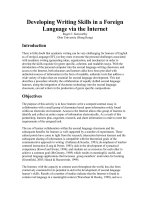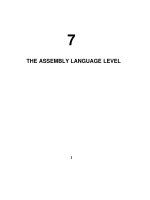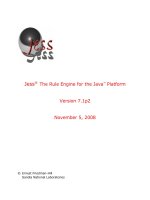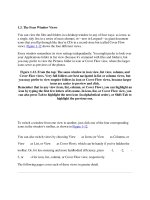Dust estimation via the triple window IR(8 7µm, 10 8µm, 12 0µm)
Bạn đang xem bản rút gọn của tài liệu. Xem và tải ngay bản đầy đủ của tài liệu tại đây (4.08 MB, 56 trang )
Dust estimation via the triple window IR
(8.7µm, 10.8µm, 12.0µm)
Can a satellite see dust particles ?
Dust particle 10 µm
Earth globe 10 Mm
From micro to mega, twelve orders of magnitude difference in size
1012 kg in the atmosphere (10-7 of atmospheric mass) = fill all lorries!
Disputed human contribution to global cooling (S.K. Satheesh, 2006)
Inert tracer for atmospheric circulation
Life vector (Saharan protozoa and bacteria to the Caribbean)
Better dust detection in the infrared?
Click one of the four fields, the one with best
contrast between free-surfaces and dust areas
•
•
On IR imagery, dusty air appears cool in contrast to the hot
daytime land surface. At night, the thermal difference
between the background and the dust lessens. Dust is not
raised by thermals, too.
On VIS imagery over water, dust is easy to note. Over
land, however, the dust plume and dry surfaces look similar
Consecutive days in Fuerteventura, January 2010
Dust on visible and infrared
2004-05-13 13:00 UTC, 0.8 µm
•Dust reflects back solar energy to space
Same date and time, 10.8 µm
•Dusty air rises and cools down
Desert scene, Southern Sudan
DUST RGB composite:
the strength of infrared for dust detection
Solar RGB composite based on
channels at 1.6, 0.8 and 0.6 µm
IR RGB composite based on
channels at 8.7, 10.8 and 12.0 µm
Aerosol and health
World Atlas of Atmospheric Pollution. Editor: R. S. Sokhi
Impact on: agriculture (fertile fields), climate (radiative balance), aviation (ash in routes)
Aerosol is more than dust
Dust
Marine salt
Smoke
(industrial carbon,
biomass burn)
Ash
Pollen
Ice crystals
Jun2000-May2001
Average aerosol
NASA Earth Observatory
?
Contents
Infrared dust properties
Where you learn how cool dust really is
A model of atmospheric dust
Where you learn to distinguish high thin from low fat
Validation via AERONET
Where you learn that models can help your eyes
Mixed scenes: cloud and dust
Where you learn that dust associates with water
Conclusions
Where you learn that there is more dust on books than
books on dust
Dust characteristics
Dust storms occasionally reach up to 1km | 5km | 10km height, and are as
thick as 100m | 2km | 5km
Over land, dust optical depth is typically around 0.1 | 0.5 | 1 or 2 | 10 | 50
for storms, in the visible range. Efficient thickness in the IR is about 40% of
those values.
Dust absorbs and scatters infrared radiation in the Mie | Rayleigh | optical
region
Aerosol density average in the atmosphere 10-7 kg/m3 ( equivalent optical
depth 0.1 | 1 | 3 )
Dust characteristics
Dust storms occasionally reach 5 km height, frequently thicker than 1km
Over land, dust optical depth is typically around 0.5 or 2 for storms, in the
visible range. Efficient thickness in the IR is about 40% of those values.
Dust absorbs and scatters infrared radiation in the Mie region
Aerosol density average in the atmosphere 10-7 kg/m3 ( optical depth 0.1)
Σscat
Σabs
0.55µm section
Dusty air ~
AOD=1 ~
1 mg/m3 ~
1 g/m2
Dust seen at a single IR channel
(280-293 K)
-Variable limits for colour enhancement
-Uncertain nature of the cold area (cloud?)
-Possible mixture of cloud and dust
2004 May 13th 13:00 Meteosat 10.8µm
colour-enhanced (left) and gray-enhanced (below)
8.7 µm
10.8 µm
12.0 µm
10.8µm
10.812µm
(-7K, 12K)
Ch9 (upper left) and three independent differences
8.710.8µm
(-19K, 5K)
(-19K, 12K)
The 10.8µm-12µm difference (vertical)
Ch 10.8µm
Dust
Dust RGB 21 March 2010 12UTC
pink is not always dust
Comparison of water cloud and dust in the IR window
Low cloud
Dust storms
8.7 µm
10.8 µm
12.0 µm
For
example: ICE
Idle ICE particle
Absorption + scattering efficiencies
10.8µm
Thin ice < 0.5
absorbs more 12.0µm
10.8µm goes forward
Active ICE particle
Abs+ scatter
12.0µm
Emissivity=0.25
:::::::::::::::::::::::::::::::::::::::::::::::::::
TRANSPARENCY EFFECT
:
Emissivity=0.30
Main contribution:
Ground, forward scattered,
1- (Absorption – Scattering)
10.8µm > 12.0µm
Ground
contribution
Dust
contribution
Emissivity=0.95
Thick ice > 1.5
emits more 10.8µm
:::::::::::::::::::::::::::::::::::::::::::::::::::
:::::::::::::::::::::::::::::::::::::::::::::::::::
EMISSION EFFECT
::
10.8µm > 12.0µm
Emissivity=0.90
Main contribution:
Cloud, emissivity,
(Absorption / Scattering)
Active DUST particle
And how
is it with
DUST?
Relaxed DUST particle
Absorption + scattering efficiencies
10.8µm
Thin dust < 0.5
absorbs more 10.8µm
12.0µm goes forward
Abs+ scatter
12.0µm
Emissivity=0.25
:::::::::::::::::::::::::::::::::::::::::::::::::::
TRANSPARENCY EFFECT
:
Emissivity=0.15
10.8µm < 12.0µm
Ground
contribution
Dust
contribution
Emissivity=0.90
Thick dust > 1.5 :::::::::::::::::::::::::::::::::::::::::::::::::::
:::::::::::::::::::::::::::::::::::::::::::::::::::
emits more 10.8µm
::
EMISSION EFFECT
10.8µm > 12.0µm
Emissivity=0.75
Reversed transparency arc for dust: Ch9-Ch10 versus Ch10
MSG Natural (solar) RGB composite
4-July-2003 10:00 UTC
10.8µm radiation is more absorbed and more backscattered by dust than 12.0µm
For dust or ash, arc is inverted due to the thinner contribution layer (CL) at 10.8µm
10.8µm channel shows higher BT than 12µm for thick dust due to higher emissivity
Single scattering albedo
Find the colour for each interaction regime
Absorbed
Back scattered
Forward scattered
Optical thickness
Single scattering albedo
Find the colour for each interaction regime
Absorbed
Back scattered
Forward scattered
Optical thickness
Channel differences: How do they generate?
• Emissivity: reduced by scattering, increased by absorption
• Sub-pixel effect: scene mixture or semi-transparency
• Contribution layer: emission from different depths and temperatures
12.0µm
No Planck weight
10.8µm -12.0µm
1
Cloud fraction
backward
scattered
forward scattered
8.7µm
Single scattering albedo
• Water vapour absorption (thermal inversion above shield cloud,
adiabatic cooling inside the Cb tower )
absorbed
Optical thickness
0
Exercise: plot 9-10 versus 10
Why is the brightness temperature difference Ch9-Ch10
positive for very thick dust layers?
T Ex
Dust shows a higher emissivity at Ch9 than at Ch10
F NEx Water vapour condenses on dust and favours Ch9 emissivity over Ch10
emissivity
T NEx Dust has a scattering component, higher at Ch9 than at Ch10
T NEx Dust Ch10 signal comes from a thicker (and therefore warmer) top layer
Ex: explains
NEx: does not explain
Contents
Infrared dust properties
Where you learn how cool dust really is
A model of atmospheric dust
Where you learn to distinguish high but thin from low fat
Validation via AERONET
Where you learn that models can help your eyes
Mixed scenes: cloud and dust
Where you learn that life is impossible without water
Conclusions
Where you learn that there is more dust on books than
books on dust
Dust model
Dust tends to higher levels far from the
source, decreasing in particle size
Du
st
Decrease in 12.0µm BT due to height and
dust thickness (and size and...)
Colder ground
Ground dust source
200 km
Dust branch
Ground branches
Model assumptions (limitations)
(32x32 surroundings): min T10.8-T12.0 < -1.3K
Empirical AOT estimates for channel saturation:
0.14----1.3----3.5----4.8
Uniform dust type
Dust in the pixel at a single height
Size not dependent on height
Ground temperature affected by thick dust above
Good results in areas 200 km across
Four result categories:
Dust-free (or low-level only, or night-time, or dry ground)
Only dust traces
Dust
Mixed with cloud









